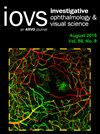STRA6 调节昼夜节律对脉络膜新生血管的影响
IF 5
2区 医学
Q1 OPHTHALMOLOGY
引用次数: 0
摘要
目的 本研究旨在探讨STRA6、昼夜节律和脉络膜新生血管(CNV)形成之间的关系,以及昼夜节律紊乱下STRA6在CNV中的调控机制。方法 将年龄为6周的C57BL/6J雄性小鼠随机分为对照组和时差组(采用每4天一次的时间转换方法,以破坏分子钟与稳定节律同步的能力)。对照组和时差组在时差两周后都建立了激光诱导的 CNV 模型。激光后第七天,通过形态学和成像检查检测 CNV 病变的大小和血管渗漏情况。通过全转录组测序筛选 STRA6。生物信息学分析评估了 GSE29801 数据集中 STRA6 的变异和关联。评估了 STRA6 在体内和体外的作用。结果昼夜节律紊乱会促进 CNV 的形成。与对照组相比,老年性黄斑变性(AMD)患者的STRA6表达水平更高,而且STRA6富集在与血管生成相关的通路中。此外,CLOCK和BMAL1是驱动昼夜节律周期的启动器,它们对STRA6也有调节作用。敲除STRA6能逆转体内昼夜节律紊乱对CNV形成的促进作用,还能影响体外无昼夜节律的RPE细胞的增殖、迁移和血管内皮生长因子分泌,并对内皮细胞产生影响。结论这项研究表明,昼夜节律紊乱后,STRA6 可抑制 JAK2/STAT3 磷酸化,从而减少 CNV 的生成。结果表明,STRA6 可能是治疗 AMD 的一个新方向。本文章由计算机程序翻译,如有差异,请以英文原文为准。
The Effects of STRA6 Regulation of the Circadian Rhythm on Choroidal Neovascularization.
Purpose
This study aims to investigate the relationship among STRA6, circadian rhythm, and choroidal neovascularization (CNV) formation, as well as the regulatory mechanism of STRA6 in CNV under circadian rhythm disturbances.
Methods
C57BL/6J male mice (aged 6 weeks) were randomly divided into control and jet lag groups (using a time shift method every 4 days to disrupt the molecular clock's capacity to synchronize with a stable rhythm). A laser-induced CNV model was established in both the control and the jet lag group after 2 weeks of jet lag. The size of CNV lesions and vascular leakage were detected by morphological and imaging examination on the seventh day post laser. STRA6 was screened by full transcriptome sequencing. Bioinformatics analysis was conducted to assess the variation and association of STRA6 in the GSE29801 dataset. The effects of STRA6 were evaluated both in vivo and in vitro. The pathway mechanism was further elucidated and confirmed through immunofluorescence of paraffin sections and Western blotting.
Results
The disturbance of circadian rhythm promotes the formation of CNV. Patients with age-related macular degeneration (AMD) exhibited higher levels of STRA6 expression compared to the control group, and STRA6 was enriched in pathways related to angiogenesis. In addition, CLOCK and BMAL1, which are initiators that drive the circadian cycle, had regulatory effects on STRA6. Knocking down STRA6 reversed the promotion of CNV formation caused by circadian rhythm disturbance in vivo, and it also affected the proliferation, migration, and VEGF secretion of RPE cells without circadian rhythm in vitro, as well as impacting endothelial cells. Through activation of the JAK2/STAT3/VEGFA signaling pathway in unsynchronized RPE cells, STRA6 promotes CNV formation.
Conclusions
This study suggests that STRA6 reduces CNV production by inhibiting JAK2/STAT3 phosphorylation after circadian rhythm disturbance. The results suggest that STRA6 may be a new direction for the treatment of AMD.
求助全文
通过发布文献求助,成功后即可免费获取论文全文。
去求助
来源期刊
CiteScore
6.90
自引率
4.50%
发文量
339
审稿时长
1 months
期刊介绍:
Investigative Ophthalmology & Visual Science (IOVS), published as ready online, is a peer-reviewed academic journal of the Association for Research in Vision and Ophthalmology (ARVO). IOVS features original research, mostly pertaining to clinical and laboratory ophthalmology and vision research in general.

 求助内容:
求助内容: 应助结果提醒方式:
应助结果提醒方式:


